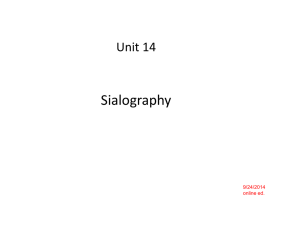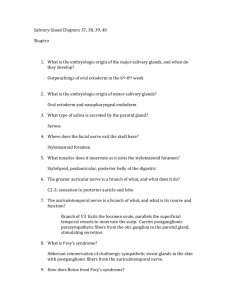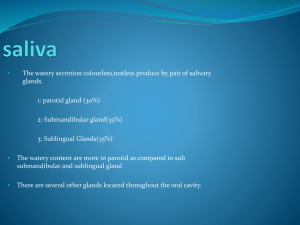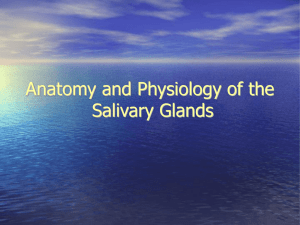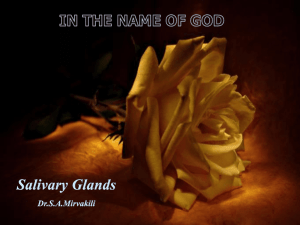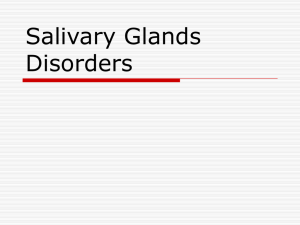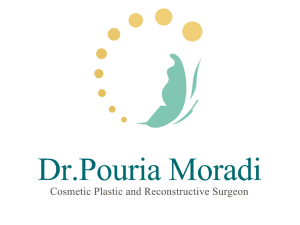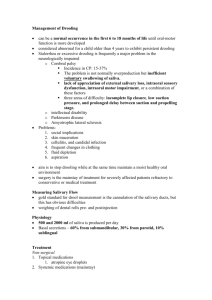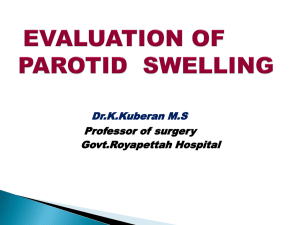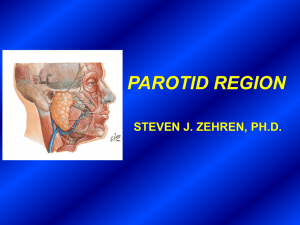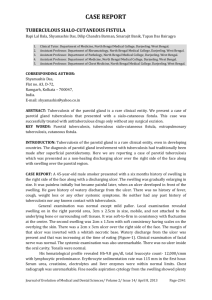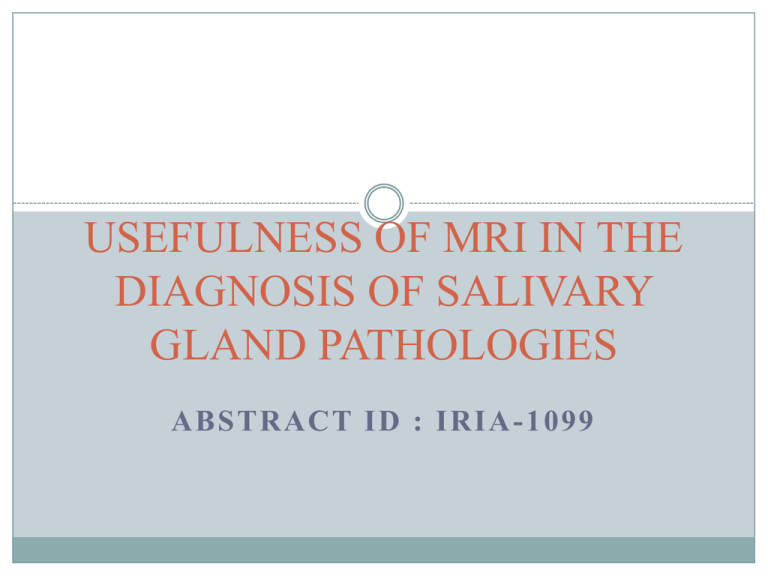
USEFULNESS OF MRI IN THE
DIAGNOSIS OF SALIVARY
GLAND PATHOLOGIES
ABSTRACT ID : IRIA -1099
INTRODUCTION
MAJOR SALIVARY GLAND
o
-PAROTID,SUBMANDIBULAR,SUBLINGUAL
• MINOR SALIVARY GLANDS
o
NUMEROUS SCATTERED THROUGHOUT UPPER
AERODIGESTIVE TRACT.
SALIVARY GLAND PATHOLOGIES
o
o
o
BENIGN NON NEOPLASTIC
BENIGN NEOPLASTIC
MALIGNANT.
INTRODUCTION
ULTRASOUND
o
Cheaper, widely available
o
fine-needle aspiration (FNA) and biopsy.
CT
o
Radio- dense calculi
MRI
o
o
o
o
o
Superficial /deep parts and the facial nerve .
To evaluate minor salivary gland disease
Perineural spread or skull base involvement of tumor
Deep spaces involvement for surgical assessment .
Thin slices (3D FIESTA) – ducts can be studied .
AIM
To assess the usefulness of MRI in the diagnosis of salivary gland
pathologies.
REVIEW OF LITERATURE
MR Imaging of Parotid Tumors: Typical Lesion Characteristics
in MR Imaging Improve Discrimination between Benign and
Malignant Disease
84 pts with parotid gland tumors were studied.
Histology was available for all tumors.
MR imaging parameters analyzed were:
o signal intensity,
o contrast enhancement,
o lesion margins (well-defined versus ill-defined),
o lesion location (deep/superficial lobe),
o growth pattern (focal, multifocal, or diffuse), and
o extension into neighbouring structures,
o perineural spread,
o Lymphadenopathy.
Christe C. Waldherr R. Hallett P. Zbaeren H. Thoeny
AJNR Am J Neuroradiol 32:1202–07 Aug 2011
Low signal intensity on T2-weighted images and
postcontrast ill-defined margins of a parotid tumor
are highly suggestive of malignancy.
MATERIALS AND METHODS
o Prospective study, May 2013- Oct 2014
o 24 Patients with suspected salivary gland disease
o 5 Excluded as follow up was not available
o MRI findings correlated with clinical follow up (10) and
surgical/ histopathological diagnosis(9) in 19 pts
TECHNIQUE
o Procedure – Head first, Head neck coil,
Scan covers salivary gland and neck region
o AXIAL– T1, T2, T2 FS,DIFFUSION,CISS,GRADIENT .
o CORONAL STIR
o SAGITTAL T2 weighted images
RESULTS
sex
PATHOLOGY
1
8
18
11
female
male
Parotid (18)
Submandibular gland (1)
PAROTID PATHOLOGY
Bilateral parotid microabscesses
1
Recurrent sialadenitis
1
Haemangioendothelioma
1
AVM of parotid
1
Parotid cyst
1
Pleomorphic adenoma
3
Parotitis
10
0
2
4
6
8
10
12
SUBMANDIBULAR GLAND PATHOLOGY
1
0.8
0.6
0.4
0.2
0
submandibular lipoma
BENIGN NON NEOPLASTIC
PAROTITIS
PAROTID CYST
AVM OF PAROTID
BILATERAL PAROTID MICROABSCESSES
RECURRENT SIALADENITIS
BENIGN NEOPLASTIC
PLEOMORPHIC ADENOMA
SUBMANDIBULAR LIPOMA
HAEMANGIOENDOTHELIOMA
DIAGNOSIS
Parotitis
Pleomorphic adenoma
MRI
10
3
FINAL
10
2
Parotid cyst
AVM of parotid
1
1
1
1
Lymphoma
0
1
Haemangioendothelioma
Recurrent sialadenitis
Bilateral parotid
microabscesses
Submandibular lipoma
1
1
1
1
1
1
1
1
16
14
12
10
MRI
DIAGNOSIS
FINAL
DIAGNOSIS
8
6
4
2
0
Malignant Benign non Benign
neoplastic neoplastic
DISCUSSION
24 YEAR MALE WITH
PAROTITIS
• Diffusely enlarged
superficial and deep
lobes of parotid
•
T 1 hypointense
• T2 hyperintense
45 YEAR OLD MALE WITH
PAROTID CYST
• Well Circumscribed
• T1 hypointense
• T2 hyperintense lesion
23 YEAR OLD FEMALE WITH
HAEMANGIOENDOTHELIOMA
• well defined lesion
•
solid and cystic components.
• T1 isointense to muscles
• T2 hyperintense
38 YEAR OLD MALE WITH
PLEOMORPHIC ADENOMA
• Well circumscribed
•
T1 hypointense
•
T2 hyperintense mass
•
smooth margins
52 YEAR OLD FEMALE WITH
SUBMANDIBULAR LIPOMA
• Well circumscribed
• T1 Hyperintense
• T2 Hyperintense
• Saturates on fat saturated
sequences
CORRELATION
Christie et al found 70% accuracy in diagnosing benign parotid lesions
and 36% in malignant lesions.
Our study showed an accuracy of 95% in diagnosing salivary gland
pathologies.
CONCLUSION
There are certain MRI characteristics for each of the common
salivary gland pathologies which helps in the exact diagnosis.
MRI showed an accuracy of 95% in diagnosis of salivary gland
pathologies.
Hence MRI is an extremely useful in the diagnosis of salivary
gland pathologies.

